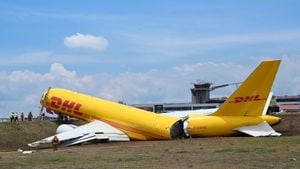NASA is currently facing significant challenges with the Boeing Starliner spacecraft, which is delaying the planned return of two astronauts, Sunita Williams and Barry "Butch" Wilmore. After experiencing several technical issues, including helium leaks, their initial eight-day mission aboard the International Space Station (ISS) has turned uncertain, with potential timelines extending all the way to February 2025.
Upon arrival at the ISS, the crew was prepared for what should have been a straightforward mission. Things took a turn when malfunctions with the Starliner spacecraft were reported, raising red flags about its safety for reentry.
Uncertainty looms over whether the Starliner will be capable of safely returning the astronauts. If it fails to meet safety standards, they might have to wait until February 2025 to return to Earth aboard SpaceX’s Crew Dragon.
Both astronauts' families have been deeply affected by the situation. Williams' husband, Michael, expressed confidence, stating, "Space is her happy place," indicating she might be thriving even amid uncertainty.
Butch Wilmore's family, on the other hand, is grappling with the disruption of important family milestones. His wife, Deanna, revealed they are facing the reality of potentially missing significant events, such as their 30th anniversary.
For the Wilmore family, the heartbreak is compounded by the forthcoming events they will miss because of Butch’s prolonged stay outside Earth. Their two daughters are adapting and have been able to connect through technology; they especially enjoy sharing views of Earth from space.
The broader impact of prolonged spaceflight is concerning not only for the astronauts but also for NASA. Concerns include the physical health of astronauts, such as bone density loss and changes to cardiovascular health due to the microgravity environment.
Examining the physiological impact of extended space missions reveals significant challenges. Astronauts can experience muscle atrophy, bone density reduction, and cardiovascular deconditioning, necessitating rigorous exercise regimens and other countermeasures.
Radiation exposure is another issue for astronauts during extended missions. The risk of increased cancer rates and potential vision changes add to the mounting health concerns associated with long-term living above the Earth.
NASA has addressed these risks for astronauts on missions but the situation with the Starliner raises additional alarm. The importance of the continued health and safety of astronauts on missions emphasizes the need for reliable spacecraft technology.
Psychological factors also come to play when astronauts experience extended missions. The isolation and confinement of space travel can lead to stress, requiring continuous mental health support alongside their physical health measures.
With each update about the Starliner and the astronauts, families and NASA continue to monitor the situation closely. The stakes are high not just for the missions themselves but for the health and safety of those conducting human exploration of space.
Looking at the future, Boeing will need to address the technical challenges to restore safety confidence to facilitate safe journeys back to Earth. Until such issues are resolved, solutions will be sought to support Williams and Wilmore during their unprecedented extended stay on the ISS.
This scenario highlights the complex nature of human spaceflight and raises questions about the readiness of current technology to support deep space activities. NASA’s active troubleshooting and resource allocation will be pivotal to overcoming these hurdles.
The lesson from this event is clear: space exploration, though awe-inspiring, involves considerable risks and unpredictable challenges. The human aspect remains at the core of every mission as families await the safe return of their loved ones.



